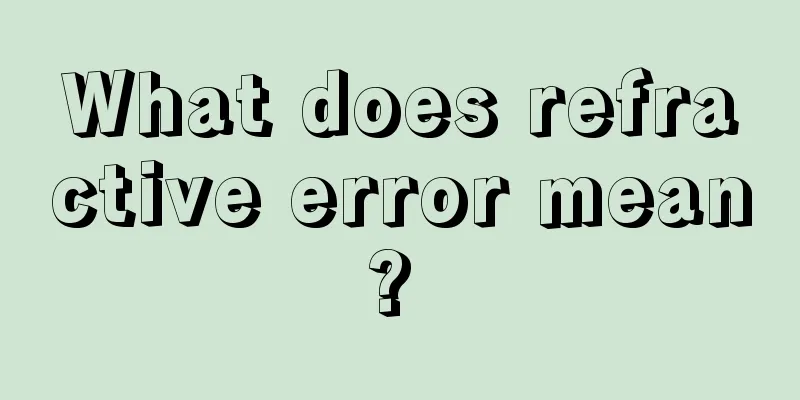What does refractive error mean?

|
Many people may not understand refractive error. In fact, there are many reasons for refractive error. Among them, genetic factors can be said to be an important reason. In addition, not paying attention to the correct use of eyes in daily life may also cause refractive error, such as myopia, hyperopia, or visual fatigue. 1. Refractive error means that when the eye is not using accommodation, parallel light rays cannot form a clear image on the retina after passing through the eye's refractive effect, but instead form an image in front of or behind the retina. It includes farsightedness, nearsightedness and astigmatism. 2. There are many reasons for refractive errors, among which genetic factors are very important. Of course, unreasonable use of eyes is also a reason that cannot be ignored. Children are in the period of growth and development, and do not pay attention to eye hygiene. For example, reading and writing postures are incorrect, or the light is poor, causing the distance between the eyes and the book to be too close, or reading for too long, or reading while walking or riding in a car, etc., can cause excessive eye fatigue and promote refractive errors. 3. Myopia Mild or moderate myopia has no other symptoms except blurred vision of distant objects. When working at a close distance, the eyes can see small targets clearly without or with little adjustment, which is convenient. However, in severe myopia, the target is very close when working, and the eyes are too focused inward, which will cause excessive use of the medial rectus muscle and cause symptoms of visual fatigue. 4. Hyperopia The vision of a hyperopic eye is determined by the degree of its hyperopic refraction and the strength of its accommodation. Mild hyperopia can be overcome with a small amount of accommodation, and both far and near vision can be normal, usually asymptomatic. This type of hyperopia is called latent hyperopia. Slightly more severe hyperopia or insufficient accommodation results in poor far and near vision. The remaining part that cannot be completely compensated by accommodation is called manifest hyperopia. The sum of latent hyperopia and visual acuity is called total hyperopia. Hyperopic eyes are prone to symptoms of visual fatigue because they are in a state of long-term accommodation tension. 5. Symptoms of visual fatigue It refers to blurred handwriting or objects, dry eyes, heavy eyelids, fatigue, eye pain and headache after reading, writing or doing close work for a long time. After a short rest, the symptoms are significantly alleviated or disappear. This symptom is most common in the afternoon and evening. In severe cases, it may even cause nausea and vomiting. Sometimes it may be complicated by recurrent chronic conjunctivitis, blepharitis or styes. |
<<: What are the effects and functions of saffron?
>>: What to do if adenoids are enlarged?
Recommend
Putting this thing on your body can actually cure diseases
If you watch ancient TV dramas, you will find tha...
What medicine should I take for thyroid cancer
What medicine should I take when I have thyroid c...
How to switch from breast milk to formula milk
When the baby is still young, parents should try ...
What are the correct treatment principles for vitiligo
Normally we rarely see patients with vitiligo, si...
Your hands and feet are sweaty and your scrotum is wet. This kind of care will keep it from getting wet
If you experience sweaty hands and feet and wet s...
What to do if there is a black mark on the buttocks
Since the buttocks are located on the back of a p...
What to do if laser mole removal leaves scars
Laser mole removal is a relatively advanced metho...
Is gypsum harmful to the human body?
Gypsum is actually calcium carbonate, and gypsum ...
Can overnight kelp be eaten? Can overnight kelp be eaten?
Many families now make their own kelp or cold kel...
How to store peeled jackfruit?
Jackfruit is a kind of fruit that many people lik...
What is the applicable scope of rectal cancer surgery
What is the indication for rectal cancer surgery?...
The eight biggest food rumors in 2014, how many did you believe?
There is never a shortage of rumors in life, espe...
What are the clinical symptoms of hysteria?
As we all know, hysteria, a mental illness, can c...
Men need to know how to touch women's breasts correctly
Female breasts are another sexual organ besides t...
What are the manifestations of nasopharyngeal carcinoma lymph node metastasis
The nasopharyngeal mucosa is extremely rich in ly...









